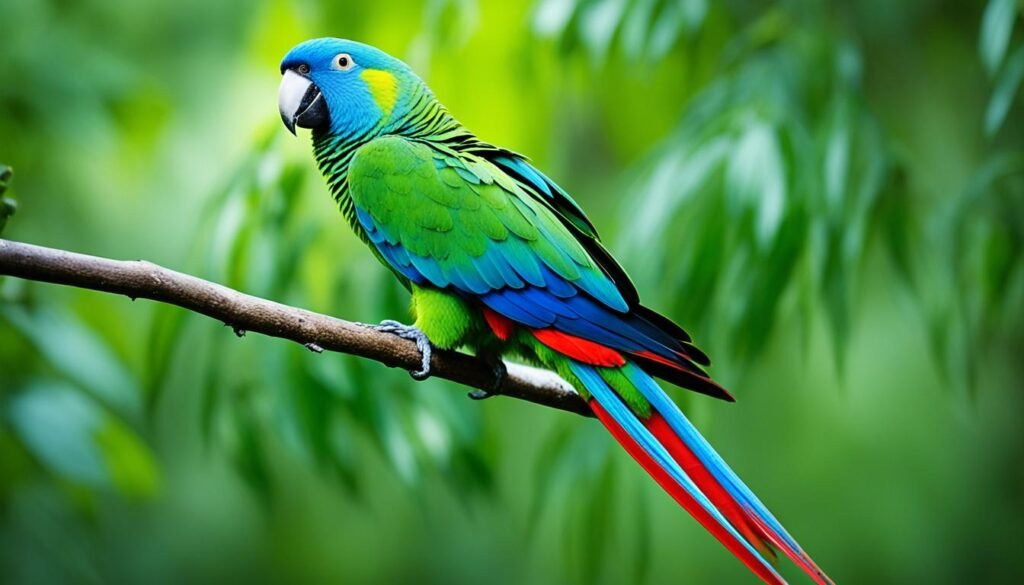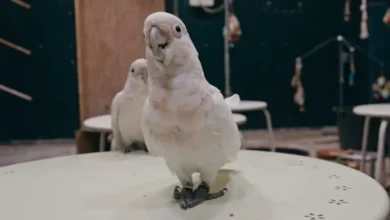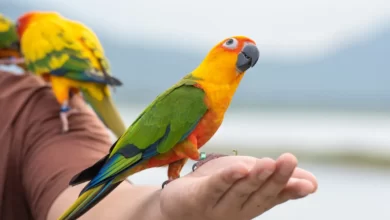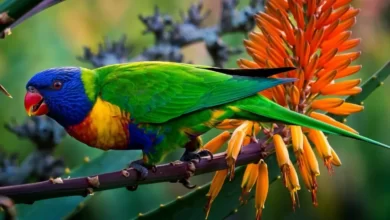Parrots of North America: Native Species Guide
Are you curious about parrots but don’t know much about the native species in North America? Dive into the world of Parrots of North America to learn about these amazing birds. We’ll cover everything from the Thick-billed Parrot to the rare Carolina Parakeet. This guide will show you where they live, how they act, and what we’re doing to save them.
Did you know there are 56 different parrot species found in 43 states in the U.S.? Discover the story of these parrot colonies and the work to protect them. Let’s explore Parrots of North America together. We’ll see how native and feral parrots mix, and what’s at stake for their future.
Introduction to Parrots in North America
Parrots, known for their bright colors and charm, have made their mark in North America’s cities. They’re not native here but have made homes in places like Los Angeles and New York City. People are curious about how these exotic birds ended up here.
Unexpected Sightings of Parrots in Urban Areas
Parrots are usually thought of as birds of the tropics, but they’re now common in North American cities. They’ve moved from being in aviaries and pet stores to forming colonies in cities. This has made locals both curious and delighted by their colorful presence and loud calls.
A Brief History of North America’s Native Parrot Species
North America once had two native parrots: the Carolina Parakeet and the Thick-billed Parrot. The Carolina Parakeet was once found all over the central and eastern U.S. but is now extinct. The Thick-billed Parrot is still fighting for survival in Mexico but is gone from the U.S. Now, most parrots in North America are not native. They’re either pets that escaped or their wild descendants.
With over 356 parrot species worldwide and many kept as pets, bringing parrots to North America is a complex issue. We’ll look into the stories of these urban parrots and the legacy of the native ones.
Identifying Feral Parrot Species
Exploring the world of feral parrots in North America is exciting for bird lovers and nature fans. Many parrot species have moved beyond their original homes. To spot these colorful birds, you need to know what to look for. By focusing on key traits, you can learn about these lively birds.
Essential Factors for Parrot Identification
Identifying parrots involves a few key points. First, notice the parrot color. Their bright greens, blues, yellows, and reds are clues. Also, look at the parrot shape, like the unique parrot bill shape and body form. These, along with their actions and where they live, help tell parrot species apart.
The Monk Parakeet is a great example of a feral parrot in North America. They stand out with their green feathers, sturdy body, and big, hooked bills. Knowing these features lets you spot Monk Parakeets in your area, like in parks or cities.
| Parrot Identification Factor | Description |
|---|---|
| Parrot Color | Vibrant hues of green, blue, yellow, and red often serve as telltale signs. |
| Parrot Shape | Pay attention to the distinct curve of the parrot bill and the overall body structure. |
| Parrot Behavior | Observe the bird’s movements, vocalizations, and social interactions. |
| Parrot Habitat | Note the bird’s preferred living environment, such as urban settings or natural landscapes. |
Learning these parrot identification tips will help you spot the many feral parrot species in North America. With an eye for detail and a love for birdwatching, you can discover the stories of these colorful birds.
Monk Parakeet: The Most Abundant Feral Parrot
The Monk Parakeet is originally from South America but now thrives in North America as the most common feral parrot. In the 1950s and 1960s, thousands of these birds were brought here as pets. Over time, some escaped or were set free, leading to their widespread population today.
Now, in over 70 years, the Monk Parakeet has made homes in at least 21 states. They are known for their unique way of nesting. Unlike other parrots, they build large, shared nests that look like small beaver dams in trees. These nests can be home to many breeding pairs, showing their social and adaptable nature.
According to birdwatching records, the Monk Parakeet is the most seen wild parrot in the northern U.S. Between 2002 and 2016, there were 42,981 sightings. They can be found in big cities like Chicago, New York, and Portland, Oregon. They often nest on man-made structures like power lines and cell towers, sometimes causing power outages.
The import of Monk Parakeets to the U.S. was banned in 1992. But, their sale and breeding are still allowed in some states. This species has shown great adaptability, making it the most common feral parrot in North America.
| Statistic | Value |
|---|---|
| Estimated Monk Parakeet Population in the U.S. | Tens of thousands |
| Number of States with Established Monk Parakeet Colonies | At least 21 |
| Monk Parakeet Sightings Logged Between 2002-2016 | 42,981 |
| Monk Parakeet Lifespan | 15-20 years, with reports up to 25-30 years |
| Monk Parakeet Clutch Size | 5-12 white eggs |
| Incubation Period | Average of 24 days |
Red-crowned Parrot: A Controversial Native or Feral?
Experts have debated the Red-crowned Parrot’s status for a long time. Some think the birds in the Rio Grande Valley of Texas are native. Others believe they escaped or were released pets. This issue is tricky because the species is endangered in Mexico, mainly due to habitat loss and the pet trade.
Conservation Challenges for the Red-crowned Parrot
The Red-crowned Parrot’s future is threatened by many issues. Feral groups have appeared in California and Florida, making conservation harder. These birds are seen as pests, causing problems with local authorities and people.
In Mexico, the Red-crowned Amazon parrots have sadly decreased from over 100,000 in the 1950s to just 3,000 to 6,500 by 1994. This shows how urgent conservation efforts are needed. The Rio Grande population is getting attention, with hopes it could help save the species in Mexico.
Scientists want to know if the Rio Grande Red-crowned Parrots are pure and can help other wild groups. DNA tests could give us answers and help with conservation plans.
The Red-crowned Parrot’s situation shows how hard it is to manage native and feral birds. It also highlights the need for strong conservation plans to protect endangered species and their homes.
Nanday Parakeet: The Distinctive Black-hooded Parakeet
The Nanday Parakeet, also known as the Black-hooded Parakeet, is a unique feral parrot in the United States. It comes from the wetlands of South America’s Pantanal region. These parakeets stand out with their yellow-green bodies, blue-black wings, and dark heads and bills.
In the US, they live in central and southern Florida, and in California’s Los Angeles and Orange County. They have made their homes in urban and suburban areas.
These parakeets are listed as Least Concern by the IUCN. They are adaptable and thrive in their new environments. They are about 11-12 inches long and weigh around 4.9 oz. In captivity, they can live up to 30 years, but usually about 18.7 years.
They eat a wide variety of foods like seeds, fruits, palm nuts, berries, flowers, and buds. They live in large groups and make a lot of noise. Females lay three or four eggs that take 21-23 days to hatch.
Nanday Parakeets sometimes mix with other species like sun conures and blue-crowned conures. But they have adapted well and spread north to Canada over time.
If you want a Nanday Parakeet as a pet, make sure you have a big cage and give them at least four hours of exercise daily. Feed them high-quality pellets, seeds, fruits, vegetables, nuts, and berries. Avoid giving them avocado, chocolate, and coffee.
The Nanday Parakeet is an interesting feral parrot that has made a home in North America. It shows how adaptable and resilient these birds can be in new environments.
Parrots of North America: Native Species Guide
North America once had two native parrot species, but now they’re mostly non-native. The Carolina Parakeet, once found in the eastern US, is extinct due to habitat loss and hunting. The Thick-billed Parrot is now in Mexico, with US reintroduction efforts failing. These parrots and their struggles are key to understanding Parrots of North America.
Over 100 native parrot species live in the Americas, with the macaws being the most colorful. The Amazona genus includes parrots like the Lilac Crowned Amazon in Mexico and Central America. The Ara genus features stunning macaws, such as the Scarlet Macaw in countries like Costa Rica and Peru.
| Parrot Genus | Notable Species | Native Range |
|---|---|---|
| Aratinga | Sun Conure, Peach-fronted Conure | South America |
| Brotogeris | Gray-cheeked Parakeet, Canary-winged Parakeet | Peru, Ecuador, South America |
| Forpus | Pacific Parrotlet, Green-rumped Parrotlet | Ecuador, Colombia, Peru, Brazil, Venezuela |
| Pionus | Blue-headed Pionus, Scaly-headed Pionus | South America |
| Pyrrhura | Rose-fronted Parakeet, Crimson-bellied Conure | Bolivia, Brazil, Peru, Ecuador |
| Triclaria | Blue-bellied Parrot | Brazil |
| Rhynchopsitta | Thick-billed Parrot, Maroon-fronted Parakeet | Mexico |
| Anodorhynchus | Hyacinth Macaw | Brazil, Bolivia, Paraguay |
Today, parrot species like the Carolina Parakeet and Thick-billed Parrot are gone from the US wild. Yet, other parrots have made their home here, either on purpose or by accident. For example, the Mitred Parakeet lives in Miami, Florida, and the Green Parakeet in McAllen, Texas.

As native birds decline, non-native parrots in North America pose complex issues. Conservationists must weigh their impact against teaching the public about our diverse bird life. This balance helps us appreciate the beauty of birds in our cities and suburbs.
Hotspots for Feral Parrot Populations
Some areas in the United States are famous for their feral parrot populations. Florida stands out as a «parrot paradise,» with over 35 species seen in Miami-Dade County. The southern part of Florida has big groups of Blue-and-gold Macaws and other parrots.
California is also a parrot hotspot. Cities like San Francisco, Los Angeles, and San Diego have many parrots. You can find Red-masked Parakeets, Yellow-chevroned Parakeets, and Blue-crowned Parakeets there. San Francisco is especially known for its wild parrots.
Florida: A Feral Parrot Paradise
In Florida, most parrots are cherry-headed conures from Ecuador and northern Peru. These birds can live over 35 years, making big groups in the city. San Francisco’s parrots spread from the Ferry Building to Brisbane and Sunnyvale, making them a citywide sight.
California’s Iconic Feral Parrot Flocks
The California parrots are loved by locals and visitors alike. They’ve been seen in places like Coit Tower and Telegraph Hill since 1911. These parrots have their own way of talking, adding to San Francisco’s charm.
Before 1992, the U.S. was the biggest importer of birds. This led to many feral parrot populations in places like Florida and California. These birds have made their homes in cities across North America, winning the hearts of people everywhere.
Urban Parrot Colonies Across the United States
Feral parrots are now common in many cities across the U.S. Besides Florida and California, other cities have seen these birds. Monk Parakeets live in Brooklyn, Boston, Houston, and New Orleans. Phoenix is home to Rosy-faced Lovebirds. Hawaii has Red-crowned Parrots on Oahu and Mitred Parakeets on Maui. These parrot colonies bring both joy and challenges to urban life.
Recent data shows that cities worldwide, like London, Paris, Hong Kong, and Singapore, have urban parrot colonies. Chicago, New York City, Los Angeles, and San Francisco are also home to these birds. Sydney, Rome, Athens, Phoenix, Dallas, Brussels, Houston, New Orleans, and Barcelona have them too. In Brussels, there are about 10,000 rose-ringed parakeets as of 2023.
The Monk Parakeet stands out, found in 43 U.S. states. They breed in the New York City and Chicago areas and are common in Texas. They even returned to New Orleans after Hurricane Katrina. In Chicago, they survive the cold by eating from backyard bird feeders from December to February.
These urban parrots often come from escaped or abandoned pets. Despite this, their numbers keep growing. Bird lovers and scientists have spotted 56 parrot species in 43 states. The Monk Parakeet is the most common, followed by the Red-crowned Amazon Parrot and the Nanday Parakeet.
These parrot colonies bring both joy and challenges. Birding fans love seeing these colorful birds. But, managing these non-native species in cities is a complex task for wildlife agencies.
Thick-billed Parrot: The Sole Surviving Native Parrot
The Thick-billed Parrot is the last native parrot in North America. It was once with the Carolina Parakeet, but it’s now alone. This parrot lives in the mountains of Mexico, where it meets other unique birds like the Violet-crowned Hummingbird and Painted Redstart.
Reintroduction Efforts and Current Conservation Status
Trying to bring back the Thick-billed Parrot to the U.S. has failed. This is because of lost habitats, development, and predators. Now, it’s listed as an endangered species. It faces threats from the illegal pet trade, losing its home, and climate change.
There are only about 1,700 Thick-billed Parrots left in the wild. They live in a small area in the Sierra Madre Occidental of Mexico. Experts think only 400-500 breeding pairs are left. The parrot’s numbers are going down, making it one of the most endangered parrots.
We need to keep an eye on nests and protect their homes to save this native parrot. Zoos like the San Diego Zoo Global are helping by breeding more parrots. But, the Thick-billed Parrot’s future is still unsure. We must keep watching and acting to save it.
The illegal pet trade is a big threat to the Thick-billed Parrot. Every year, thousands of parrots, including these, are caught in Mexico for pets. Logging and wildfires are also destroying their homes, hurting their numbers.
Previous attempts to reintroduce 88 Thick-billed Parrots in Arizona didn’t work. The last time a flock was seen in the U.S. was in 1938. The reintroduction stopped in 1993, with no more sightings since 1995.
The Thick-billed Parrot is a special bird that once lived in the U.S. and Mexico. Even with big challenges, we’re working to save this native parrot. We want to make sure it can live on for many years.
Parrot Behavior and Adaptations
Parrots in North America show many interesting behaviors and adaptations. They live in groups and move together like geese. Many prefer to nest in tree holes, using old woodpecker nests.
These birds are famous for their loud calls. They use these to talk to each other, warn of danger, and show their unique personalities. Some, like the Thick-billed Parrot, even eat snow in cold places.
Learning about parrot behavior and parrot adaptations helps us understand these amazing birds better. From how they eat to where they live and what sounds they make, parrots have adapted to many different environments in North America.





